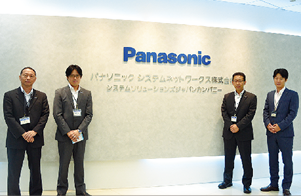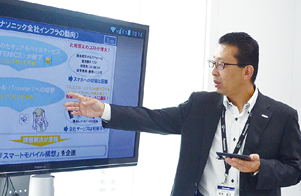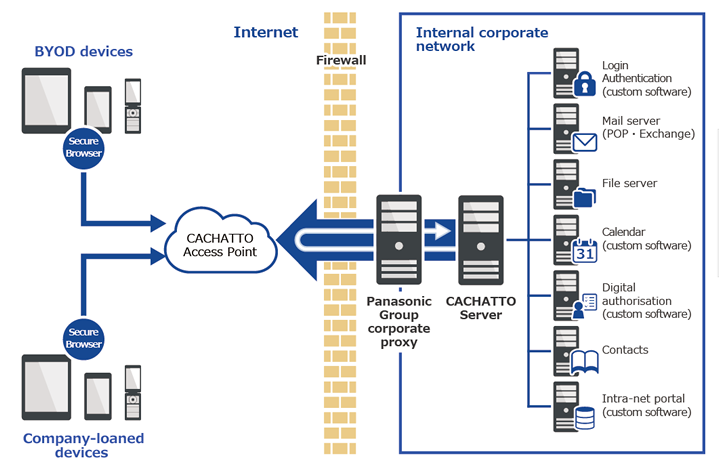Panasonic System Solutions Japan Co., Ltd.
Using CACHATTO to restore mobility lost with strengthened security
~Immediate actualisation of BYOD through self-developed applications~
Mr. Takahisa Inata
- Information System Department
- General manager
Mr. Hiroyuki Fujii
- Information System Department
- ICT Strategic Planning Section Manager
Mr. Masatsugu Konishi
- Information System Department
- ICT Strategic Planning Section Councilor
Mr. Takayuki Nozaki
- Information System Department
- ICT Strategic Planning Section Director

Panasonic System Solutions Japan Co., Ltd. provides total solutions as per the Panasonic standard in both business and social systems. From development, production, retail, and service as a whole, System Solutions Company (Japan) aims to support the customers' type of enterprise and corporate restructuring by delivering 'new value'. System Solutions Japan implemented CACHATTO as a platform for 'smart mobile conception' in fall 2014 in order to strengthen the salesperson’s mobility and to maximize time spent with customers. They gave details and explained the circumstances that made it possible to quickly actualise BYOD.
First, we asked System Solutions Japan’s Information System Department General Manager Takahisa Inata about the catalyst for choosing CACHATTO.
'The standardised remote-access service for smartphones and mobile phones that Panasonic Group was using was terminating their service for legacy mobile phones in spring 2015. The service for smartphones was due to shift to a new system in spring 2016. At our company, roughly 2000 corporate mobile phones have been lent to employees, and the topic of cost to switch to smartphones came up. Furthermore, the new system suggested by the Panasonic Group would not delete email data from the device; as devices that retain data are forbidden to be taken out of the company as per company policy, the service in question did not measure up to our security standards.'
Having experienced information security issues in the past, we have more stringent rules than the Panasonic Group as a whole. As a result, the service in question would not hold up to our desired security level. To address this problem, we began looking for an independent system to implement,' Mr Inata continued. 'With the distribution of smart devices and tablets, the company was concerned about cost. Furthermore, even if the smart devices were distributed, they would soon become obsolete, and each device would be another information security risk. On the other hand, employees who would use the company smartphones ran the risk of losing the device and data on it, as well as be inconvenienced by having to carry both a company phone and their personal phone. What we truly desired was a mobile environment that would balance security with convenience.
Even from the standpoint of cost, upgrading all company mobile phones to smartphones, and distributing company smartphones would be difficult; to avoid this we determined that BYOD would be a necessary prerequisite to the infrastructure.'
In April 2014, the Information System Group began their 'smart mobile conception', which aimed to use smart devices to increase work efficiency by effectively using spare time, thus maximising time spent with clients.
You can check your email and schedule before arriving at work, and send approvals during your commute. You can skim through your negotiation materials before your arrival, and even give the presentation with your smartphone. And as long as you didn’t have any important emails to respond to, you could head straight home after work. This is the kind of workstyle we were aiming for.'
'First, we received a user account for the trial evaluation to verify the company system, and began working on the necessary contents. By July, three months later, we had gotten Human Resources and the Information Security Department involved and launched the project. We then proceeded by reviewing labour management issues and began making information security rules and manuals for BYOD.' said Mr Inata.
General Manager, Mr Fujii, explained about the product selection and function verification. 'No data being left on the device, and a polling system that ensures safety by not having a direct-access route were big factors from a security perspective. Not needing to change the firewall settings for implementation was a crucial factor in receiving approval from the company’s regulatory department. From the viewpoint of functionality, the swift mail-display function, the multi-task feature, and the mobile phone interface were the deciding factors. Furthermore, case studies on the use of CACHATTO by other companies and government offices which have high standards for security greatly influenced our product selection.'
After that, the company began moving toward implementing the full version of CACHATTO, and the department that handled the company’s cloud operations was put in charge of the project.
'While normally the Information System Department manages in-house systems, this time the Cloud Service Operations Center, who manages the cloud service, took to the task. The reason for this was to be available 24 hours a day, 365 days a year, to prevent access to CACHATTO in the event a device is lost, and also to be able to close CACHATTO accounts after 3 months of inactivity. They gathered all of the information on in-house system operations from the business unit, with the added intention of selling CACHATTO.' said Mr Fujii.
Next, we asked users about any problems they faced during the implementation. One problem the company particularly struggled with was getting the approval to begin BYOD from the Information Security Regulatory Department, and setting up enough explanation sessions for the employees.
First, Mr Inata elaborated on getting approval for implementing CACHATTO and BYOD.
'With 24-hour mail monitoring, restrictions on copying data between PC and USB memory drives or SD cards, and PC activity logs, our company has much more stringent security rules than the rest of the Panasonic Group.
As the first within the group to attempt BYOD, we evaluated all security risks, established clear operational rules and went to great lengths to thoroughly explain everything to the Information Security Regulatory Department.
In the end, they determined that 'due to the many levels of safeguards, there was an extremely low risk of an information breach', and we were able to obtain approval and be the first company in the Panasonic Group to start BYOD.’
Over 100 user-oriented hands-on sessions were held at 20 major branch locations around the country.
'In order to impress that this was not just a system update, we held the presentations with our smart devices, and introduced the best features and functions. It was necessary to express points of caution concerning BYOD, as well as the new regulations in place for access outside of work hours. We also wanted the opportunity to speak individually with those who were hesitant about BYOD.' said Mr Fujii.
6 months after the project was started, CACHATTO was fully implemented according to plan in October 2015.
The management class was the first to use it, and by November the usage extended to the rest of the company. The user base steadily grew, with over 2,400 users by the end of October 2015, amounting to a 60% rate of BYOD users.
A distinguishing feature of their system is their original custom software, the 'Smart portal', which was designed to function alongside CACHATTO’s portal link.
The 'Smart portal' allows access to company schedules, address books, and sales data management systems, but also contains a number of original, self-developed work assistance tools under its 'Utility' section. These assistance tools are explained below:
'Paperless Meeting System'Meeting materials are uploaded to a specific site and automatically converted to PDF; participants can view these documents on their smart devices, thus reducing the amount of printed materials.
In addition, the documents can be viewed on a large monitor by connecting the smart device to a TV monitor with a wireless adapter, allowing for presentations during the meeting.
'Gaishutsu-kun' ('Mr Going-out')'Gaishutsu-kun' is a system in which users can upload business documents, etc., to their individual web pages, and view them when they are meeting with a client. Other users can upload files to each other’s web pages; this is especially helpful when in sudden need of a particular document, which can then be uploaded by another employee at the office.
With a TV output adapter, the sales representative can even display the documents to show the client, and thanks to that, some of the clients become interested in implementing CACHATTO themselves.
While viewing a file is possible via a file server, 'Gaishutsu-kun' automatically converts the document to PDF, embedding fonts and compressing the file compressed to be smaller.
'Shako-tan' ('Miss Photo-storage')'Shako-tan' is a tool that was developed on request by the Main Construction Department to be able to use photos from the field in their reports. Photos taken on a smart device can be uploaded to the intranet server and accessed from a company PC. After the photo is uploaded, the photo data does not remain on the device.
In part due to the usefulness of these tools, CACHATTO usage within the Sales Department was over 90%. Being able to give presentations with a smart device was apparently an especially valued feature.
'For a desktop PC user to give a presentation in a meeting room, they would have had to borrow a communal note PC, copy their documents onto it, and bring it in. Many people are very happy that this tedious step is no longer necessary.' said Mr Inata. Furthermore, the ability to adjust schedules and reserve meeting rooms on a smartphone while already in a meeting was also reportedly very popular. It seems that the usefulness of these tools led to more users.
'All that is needed to prevent shadow IT is to provide tools that people will use. We will continue to prioritise development on requested tools that encourage productivity.' said Mr Inata.

Mr. Inata demonstrates the paperless-meeting system during the interview using his smartphone
Finally, we asked Section Councilor Masatsugu Konishi if there were any requests for improving CACHATTO.
'For our company email and schedule we are planning on switching from our personalised system to Exchange. Since the response time, operability, functions, etc. are different, it’s possible that people will think it is difficult to use; to avoid that, it would be helpful for CACHATTO to be able to make up for some of those differences.' said Mr Konishi.
Lately, there have apparently been opportunities for the Information System Department to guide discussions on CACHATTO as well. 'We receive requests from other companies' Information System departments to talk about our experiences on our BYOD implementation project, and we occasionally accompany our sales department teams on visits to talk about CACHATTO. Our Information System Department aims to contribute in this way as well.' said Mr Inata.
It was easy to see the strong drive of the IT Management, which was evident in the way the System Information Department was always thinking one step ahead for improvement.
System structure diagram

*2 Microsoft Exchange Server (Microsoft Corp. product)
